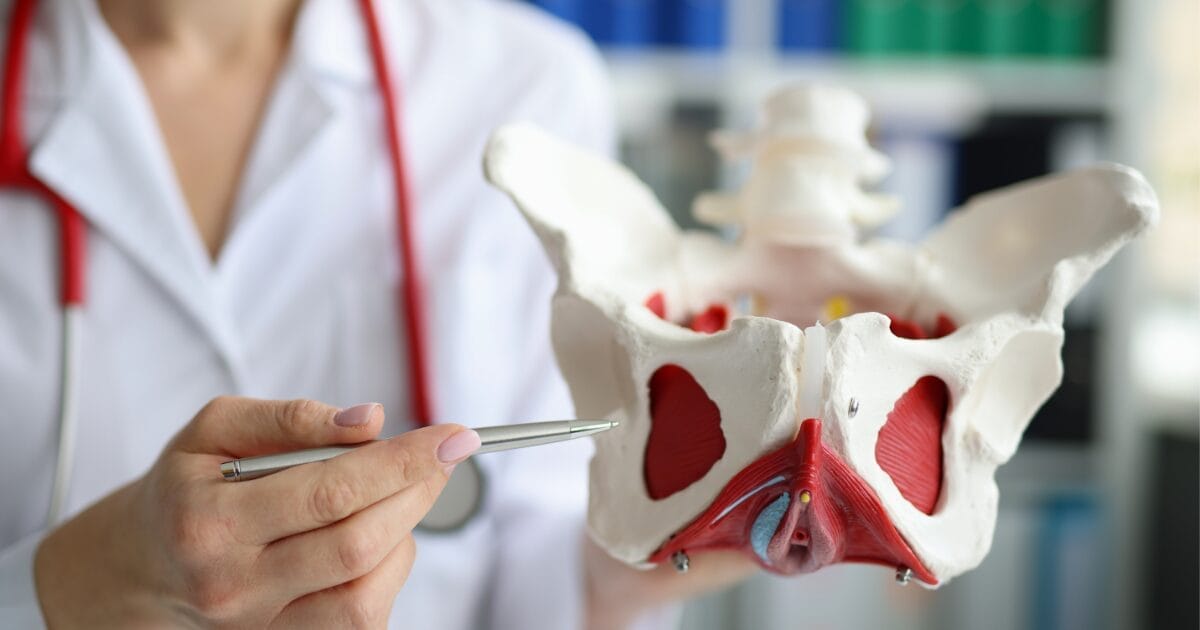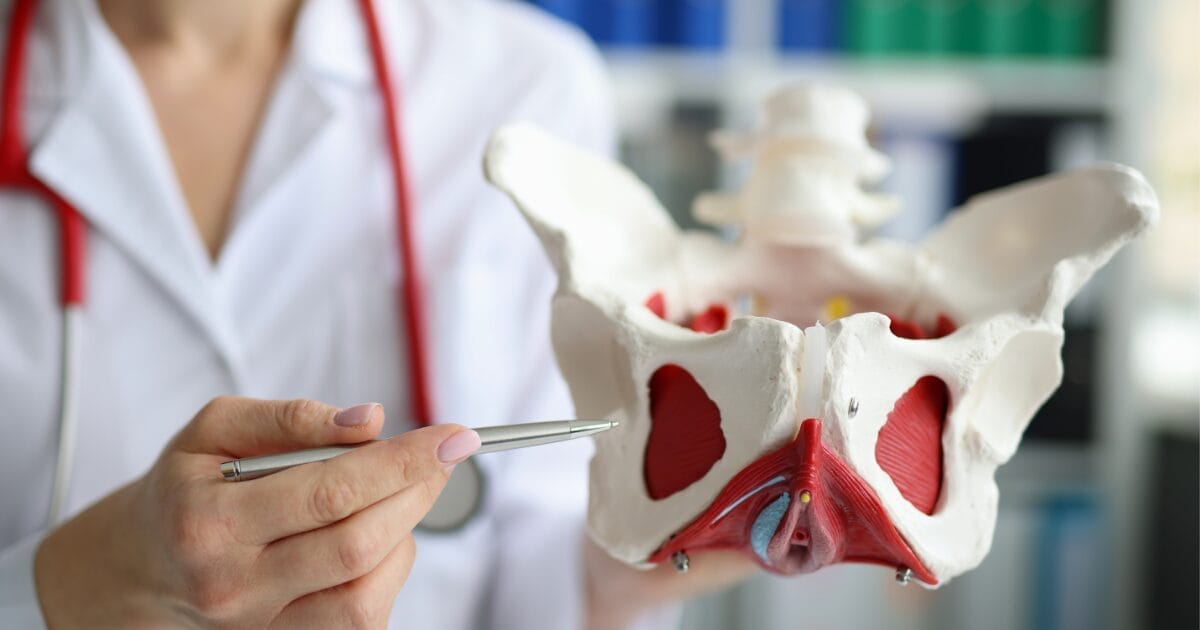Understanding Pelvic Organ Prolapse: Non-Surgical Answers
Pelvic organ prolapse is a condition where the pelvic organs drop down into or through the vaginal canal, affecting a large number of women, especially after menopause. Often, the immediate solution has been surgery to fix this uncomfortable problem. But now, thanks to new research and better understanding, more women have access to effective non-surgical…

Pelvic organ prolapse is a condition where the pelvic organs drop down into or through the vaginal canal, affecting a large number of women, especially after menopause. Often, the immediate solution has been surgery to fix this uncomfortable problem. But now, thanks to new research and better understanding, more women have access to effective non-surgical treatments.
These alternatives include making healthy lifestyle changes, using pessary devices, doing pelvic floor exercises, trying biofeedback, and undergoing electrical stimulation therapy. Also, by adjusting one’s diet and receiving specialized pelvic floor therapy, women are finding relief and improving their lives without the need for surgery.
These non-surgical methods are not just about managing symptoms—they could change how pelvic organ prolapse is treated and offer a safer approach for many. They deserve serious consideration for anyone looking for long-term solutions.
For example, a simple change like incorporating more fiber into your diet can improve bowel health and alleviate some pressure on the pelvic floor. Or consider a pessary, a device inserted into the vagina that provides support to the pelvic organs. It’s a safe and effective option that many women have found helpful.
It’s also worth noting that pelvic floor exercises, commonly known as Kegels, can significantly improve prolapse symptoms by strengthening the muscles that support the pelvic organs. And for those who need a bit more help, biofeedback and electrical stimulation therapy are there to guide and enhance muscle training.
The key takeaway here is that surgery isn’t the only path to relief for pelvic organ prolapse. With the right combination of treatments, women can live comfortably and with confidence. Remember, everybody is different, so it’s important to work with a healthcare provider to find the best plan for you.
In summary, non-surgical treatments for pelvic organ prolapse are proving to be a boon for many women, offering a safer and often equally effective alternative to surgery. With options like lifestyle changes, pessary use, and pelvic floor therapy, there’s a growing recognition that these methods are worth considering and can lead to a better quality of life.
Key Takeaways
Understanding Pelvic Organ Prolapse: Non-Surgical Options
Pelvic organ prolapse is a condition that affects a significant number of women, particularly post-menopause. This condition causes the pelvic organs to descend into or protrude through the vaginal canal, leading to discomfort. While surgery was once a common approach to addressing this issue, advances in research have opened the door to effective non-surgical alternatives.
Women are now finding relief through a variety of methods that do not require surgery. These methods include adopting healthier lifestyle habits, using pessary devices, performing pelvic floor exercises, engaging in biofeedback, and undergoing electrical stimulation therapy. Dietary adjustments and specialized pelvic floor therapy also play a role in providing comfort and enhancing quality of life.
The approach to treating pelvic organ prolapse is evolving, with these non-surgical options presenting a less risky path for many. They should be considered by those seeking lasting solutions.
For instance, increasing dietary fiber can lead to better bowel health, lessening the strain on the pelvic floor. A pessary, a device placed inside the vagina to support the organs, has proven to be a reliable and valuable option for numerous women.
It’s also significant to acknowledge that pelvic floor exercises, or Kegels, can improve the strength of the muscles that support the pelvic organs, thereby alleviating symptoms of prolapse. For additional support, biofeedback and electrical stimulation therapy are available to assist in muscle training.
The main message is that surgery is not the sole avenue for relief from pelvic organ prolapse. A tailored combination of treatments can enable women to live comfortably and with confidence. It’s crucial to consult with a healthcare provider to determine the most suitable treatment plan.
A Custom Quote: “Knowledge of all available health options brings empowerment. Non-surgical treatments for pelvic organ prolapse represent a significant shift, offering effective relief without surgical risks.”
In summary, non-surgical treatments for pelvic organ prolapse are increasingly recognized as a less invasive and often just as effective alternative to surgery. With a range of options including lifestyle modification, pessary usage, and pelvic floor therapy, these treatments are becoming a preferred choice for many women, leading to improved quality of life.
Understanding Pelvic Organ Prolapse
Understanding Pelvic Organ Prolapse
Pelvic organ prolapse (POP) occurs when the muscles and ligaments supporting a woman’s pelvic organs weaken. This can cause the bladder, uterus, or rectum to drop and press against the vaginal wall. This condition can have a considerable impact on a woman’s day-to-day life, and it’s essential to know both how to prevent it and what treatment options are available.
Staying proactive about pelvic health is key, and this includes addressing factors like excess weight, avoiding chronic straining, and reducing activities that put excess pressure on the abdomen. When lifestyle changes aren’t enough, there are surgical options available. These surgeries are designed to repair the affected area, but they are not without potential complications and the possibility of the prolapse happening again. It’s critical for a patient and her doctor to carefully weigh the severity of symptoms against the risks of surgery.
Prevention and Treatment of Pelvic Organ Prolapse
To prevent the occurrence or worsening of POP, maintaining a healthy weight and regular bowel movements is advised. Pelvic floor exercises can also strengthen the muscles and provide better support for the pelvic organs. When non-surgical methods don’t provide relief, surgery may be the next step. The two main types of surgery are reconstructive, which aims to rebuild the pelvic floor, and obliterative, which shortens or closes the vaginal canal.
It’s important to consult with a healthcare provider to determine the best course of action based on individual health and the severity of symptoms. Remember, the decision to undergo surgery should be made after careful consideration of the potential benefits and risks.
‘Taking control of your pelvic health is not only about treatment; it’s about making lifestyle choices that support your body’s natural structure and function.’
Lifestyle Modifications for Symptoms
Managing symptoms of pelvic organ prolapse can greatly benefit from making certain lifestyle changes. It’s important to focus on maintaining a healthy weight because carrying too much weight can increase the pressure inside your abdomen, which might make prolapse symptoms worse. Advising patients on eating a balanced diet and engaging in regular exercise helps to lower their body mass index to a normal range, which can relieve some of the pressure on the pelvic floor.
Reducing stress is also key, and this can be done through practices such as mindfulness, yoga, and other calming activities. These methods help to decrease the stress response in the body, which can lead to muscle tension, and they also promote a sense of overall wellness that may help cope with the broad effects of prolapse symptoms on someone’s life.
Custom Quote: ‘Taking control of your wellness through mindful lifestyle choices can transform your experience with pelvic organ prolapse, turning challenges into opportunities for improved health.’
Pessary for Prolapse Management
Pessary for Prolapse Management
A pessary, which is a medical device placed inside the vagina, provides support for those dealing with pelvic organ prolapse, helping to ease the discomfort that comes with it. It’s essential to choose the right pessary for each person, considering the unique structure of their body, how severe the prolapse is, and what feels comfortable for them.
Healthcare providers need to carefully determine the best type, size, and design of the pessary to ensure it supports well without damaging the delicate tissue of the vagina.
Taking care of a pessary means having regular check-ups to watch for issues like vaginal sores or infections. It’s also vital to teach patients how to look after their pessary, including how to clean it and, when necessary, how to manage it themselves.
A team approach is best for managing prolapse with a pessary, involving the skills of gynecologists, specialists in female pelvic medicine and reconstructive surgery, and pelvic floor therapists for a well-rounded treatment plan.
A Custom Quote: ‘Choosing the right pessary is like finding the perfect pair of shoes; it needs to fit well, feel comfortable, and support you through the day.’
Pelvic Floor Exercises
Pelvic Floor Exercises
Pelvic floor exercises, especially Kegel exercises, are well-known for their role in strengthening the muscles that support the pelvic organs. Doing these exercises can help lessen symptoms and, for some people, can even reduce the severity of organ dropping down. It’s beneficial to consider other muscle-strengthening methods along with Kegel exercises for a well-rounded, non-surgical treatment plan for pelvic organ drop.
Kegel exercises involve repeatedly contracting and relaxing the muscles of the pelvic floor. This can lead to stronger muscles and more support for the bladder, uterus, and bowels. Regular practice may result in better bladder control and improved sexual function.
For those dealing with pelvic organ drop, it’s not just about doing Kegels; it’s also about looking at other exercises that can build muscle strength in the area. This could include Pilates or yoga, which focus on core strength and may complement the benefits of Kegel exercises.
Remember, before starting any new exercise regimen, it’s wise to consult a healthcare professional. They can provide guidance tailored to your specific needs.
Incorporating these exercises into your daily routine can make a significant difference over time. It’s not an instant fix, but with patience and consistency, many individuals notice improvements.
Personalized Advice: If you’re unsure where to start, seek out a physical therapist specializing in pelvic floor health. They can teach you the correct techniques and help create an exercise program that’s right for you.
By maintaining a consistent exercise routine and staying informed about your health options, you can take charge of your pelvic health. Remember, taking care of your body involves both knowledge and action.
‘Don’t underestimate the power of simple exercises; a little effort each day can lead to significant changes in your well-being.’
Kegel Exercise Benefits
Kegel exercises are a simple yet effective way to make your pelvic floor muscles stronger. These exercises are particularly beneficial for those dealing with pelvic organ prolapse. By regularly performing Kegels, you can help keep your pelvic organs in place and manage the pressure within your abdomen better.
Doing Kegel exercises works out a group of muscles called the levator ani. This is important because these muscles form a supportive sling for your pelvic organs. Strengthening them can have added advantages, such as improving your sexual health. Many people find that Kegels lead to increased sensation and a better sexual experience because they improve muscle tone and blood flow in the pelvic area.
Learning how to do Kegel exercises properly is key to getting these benefits. It can be as simple as squeezing the muscles you would use to stop the flow of urine, holding for a few seconds, and then releasing. It’s about building a habit and doing these exercises regularly to see improvements.
In terms of sexual health, Kegel exercises can make a big difference. They can make intimate moments more enjoyable and satisfying. This is a great example of how a little effort can go a long way in improving your overall well-being.
Kegel exercises are not just about dealing with current symptoms. They’re also about prevention. By keeping your pelvic floor muscles strong, you can reduce the risk of issues developing in the future.
In a relaxed and engaging manner, remember that incorporating Kegel exercises into your daily routine doesn’t have to be a chore. It’s a positive step towards taking care of your body and enhancing your quality of life.
To sum it up, if you’re looking for a straightforward way to improve your pelvic health, give Kegel exercises a try. They might just be the boost you need for a healthier and more comfortable life.
Alternative Strengthening Techniques
In addition to the well-known Kegel exercises, there are a variety of other methods to strengthen the muscles of the pelvic floor and help with the discomfort caused by pelvic organ prolapse. Exercises that focus on core stability are essential for supporting the pelvic organs. These exercises work not only the pelvic floor muscles but also the transversus abdominis, the multifidus, and the diaphragm, all of which work together to support the pelvic region.
Correcting posture is also vital. When the body is properly aligned, it puts less strain on the pelvic floor, which can make strengthening efforts more effective. Health professionals can make a big difference in managing pelvic organ prolapse without surgery by teaching patients about the right way to hold their bodies and using exercises designed to improve spinal alignment.
Why It Matters
Building a strong pelvic floor is more than just fitness; it can significantly improve one’s quality of life, especially for those experiencing pelvic organ prolapse. These muscles are like the body’s internal support system, and keeping them robust can lead to better control and stability.
Keep It Natural
Remember, the best results come from a natural, balanced approach. It’s not just about doing one type of exercise but integrating a variety of methods that work together.
In Summary
Taking care of your pelvic floor is a proactive step towards maintaining your overall health. By incorporating core exercises and focusing on proper posture, you can build a solid foundation that supports your body from the inside out.
Custom Quote: ‘A strong foundation supports not just our bodies, but our overall well-being. Prioritize your pelvic health for a life lived with confidence and control.’
Biofeedback for Pelvic Control
Biofeedback therapy is a modern method to help people improve control of their pelvic floor muscles, especially for those dealing with pelvic organ prolapse. This technique provides immediate feedback, which helps patients improve the coordination and relaxation of their muscles in a specific area— the pelvic floor. By watching how their muscles contract on a screen, patients can learn to adjust the strength and duration of these contractions, leading to better support for their pelvic organs.
In the process of biofeedback for better control of the pelvic area, doctors follow a detailed plan that adjusts to each person’s reactions, aiming for steady progress. Medical professionals teach a set of exercises that build up a person’s ability to sense and control their pelvic floor muscles, leading to a stronger and more synchronized muscle structure. This safe method is key for people who want to lessen their prolapse symptoms and achieve better control over their bodily functions.
Understanding Biofeedback Therapy
Biofeedback therapy is not just about exercises; it’s about teaching patients how to control their bodies using the feedback they see and feel. With this understanding, they can better manage their condition and potentially avoid further complications or the need for more invasive treatments.
Why Biofeedback Matters
For those dealing with conditions like pelvic organ prolapse, the ability to strengthen the pelvic floor can mean a significant improvement in quality of life. Biofeedback offers a way to address these issues head-on, with the potential for long-term benefits.
The Role of the Practitioner
A practitioner’s role is vital in this therapy. They not only provide the necessary instructions and adjustments to the exercises but also offer support and encouragement throughout the treatment process, which can be just as important for the patient’s success.
The Non-Invasive Advantage
The non-invasive nature of biofeedback therapy means that patients do not have to go through surgery or take medications to improve their pelvic floor muscle control. This aspect makes it an attractive option for many.
In Summary
Biofeedback therapy stands out as a beneficial approach for those looking to improve pelvic floor muscle control and manage symptoms of pelvic organ prolapse. With the guidance of skilled practitioners and the use of innovative technology, patients can achieve a better understanding and ability to manage their pelvic health.
Custom Quote: ‘Biofeedback therapy empowers individuals to take control of their pelvic health, turning insight into action for a stronger, more coordinated pelvic floor.’
Electrical Stimulation Therapy
Electrical Stimulation Therapy
Electrical stimulation therapy is a helpful tool in managing pelvic organ prolapse and improving the function of pelvic floor muscles. It works by using a device to send gentle electrical pulses that cause the pelvic floor muscles to contract. These contractions are similar to voluntary exercises and help build muscle strength and stamina. It’s important to choose the right device for each person, considering their unique anatomy and the severity of their prolapse. The length of treatment can vary, often lasting weeks or months, depending on how much muscle weakening there is and how quickly the muscles and nerves respond to the therapy. This treatment can be a key part of a broader prolapse management plan and may reduce or eliminate the need for surgery.
Here’s a straightforward way to look at it: think of the pelvic floor like a sling that holds up the organs in the pelvis. If this sling weakens, organs can slip out of place, which is what happens with prolapse. Electrical stimulation therapy acts like a targeted workout for that sling, making it stronger and more supportive.
The treatment isn’t one-size-fits-all. A healthcare provider will work closely with each patient to find the best device and treatment plan for them. The goal is to make those pelvic floor muscles stronger so they can do their job better, which can make a big difference for someone’s quality of life.
In some cases, sticking with this therapy over time can mean avoiding surgery, which is a big deal for many people. It’s a non-invasive way to tackle a problem that can be very uncomfortable and even embarrassing.
Remember, it’s not just about avoiding surgery. Stronger pelvic floor muscles can mean fewer symptoms and a lower chance of the prolapse getting worse. That means less worry and more freedom to enjoy everyday activities without discomfort.
Dietary Changes for Alleviation
Dietary Changes for Better Pelvic Health
When it comes to improving pelvic floor strength, electrical stimulation therapy can be effective, but you can also support your body by changing what you eat. Making smart choices in your diet can help ease the discomfort of pelvic organ prolapse by lowering the pressure on your abdomen.
Staying hydrated is one key change. Drinking enough water helps keep your stools soft, making it easier to avoid constipation, which often makes prolapse symptoms worse because of the need to strain.
Eating plenty of fiber is another vital step. By including a variety of fiber sources like fruits, veggies, beans, and whole grains in your meals, you can ensure more regular bowel movements and reduce the pressure on your abdomen when you go to the bathroom. This dietary approach is a key part of a broader plan to manage and slow down the progression of pelvic organ prolapse without surgery.
Pelvic Floor Therapy Explained
Pelvic floor therapy plays a crucial role in managing pelvic organ prolapse. It includes various exercises and techniques aimed at strengthening the pelvic floor muscles and reducing symptoms. The approach focuses on improving muscle coordination and follows a step-by-step treatment plan.
Key Elements of Pelvic Floor Therapy:
- Muscle Strengthening:
- Practicing Kegel exercises to build muscular endurance.
- Using biofeedback to track muscle activity and confirm correct exercise execution.
- Relief of Symptoms:
- Applying electrical stimulation to boost nerve and muscle interaction.
- Performing manual therapy to ease muscle tension and pain.
Health professionals customize these treatment plans to meet the specific needs of individuals, gradually increasing the intensity to enhance pelvic floor strength and control. Gaining proficiency in these techniques is vital for the long-term treatment of pelvic organ prolapse.
Clinicians emphasize the importance of these strategies, not just as a list of tasks, but as a way to improve quality of life. Regular practice of the prescribed exercises can lead to significant improvements in pelvic health, allowing individuals to engage in daily activities with greater comfort and confidence.
In a world where medical jargon can be overwhelming, pelvic floor therapy stands out as a practical and beneficial method for those experiencing pelvic organ prolapse. It underscores the power of targeted physical therapy to foster recovery and maintain wellness.
Frequently Asked Questions
How Does Pelvic Organ Prolapse Affect Sexual Function and Intimacy, and What Can Be Done to Improve This Aspect of Life?
Pelvic organ prolapse can disrupt sexual activity and reduce the closeness that partners feel. To improve this situation, performing exercises that target the pelvic floor muscles can offer physical support, while seeking therapy may help couples navigate the emotional and relational challenges associated with prolapse.
When dealing with pelvic organ prolapse, it’s not just the physical discomfort that can be troubling; the impact on a person’s sex life and self-esteem might be significant. This is why it’s beneficial to consider not only physical therapies but also emotional support. Engaging in exercises like Kegels can help rebuild muscle strength around the pelvic region, potentially restoring some of the physical function necessary for a satisfying sex life.
On the other hand, speaking with a therapist or counselor who specializes in sexual health or relationship issues can offer a safe space to discuss feelings and concerns. This can also lead to strategies that help both individuals and couples feel more connected and less stressed about the prolapse during intimate moments.
Custom Quote: “Finding balance in the face of pelvic organ prolapse means nurturing both the body and the heart—strengthening the physical foundation while keeping the emotional connections strong.”
Are There Any Alternative or Complementary Therapies, Such as Acupuncture or Herbal Treatments, That Have Been Shown to Be Effective for Pelvic Organ Prolapse?
The effectiveness of acupuncture for treating pelvic organ prolapse isn’t clear yet, as there haven’t been many detailed studies on the subject. On the other hand, some herbal treatments seem promising, but they need more research to confirm that they’re safe and actually help people with this condition.
When considering alternative or complementary therapies for health issues like pelvic organ prolapse, it’s crucial to rely on methods backed by scientific evidence. While acupuncture is a traditional practice that many find beneficial for various conditions, its role in treating pelvic organ prolapse is still under review. Researchers are looking into specific herbal treatments that could potentially provide relief for those suffering from prolapse, but it’s vital that these alternatives go through a rigorous process of testing to ensure they do more good than harm.
If you’re interested in these kinds of therapies, it’s a good idea to talk with healthcare professionals who specialize in pelvic health. They can give you the most up-to-date information on what treatments might be helpful and safe.
Remember: Always consult with a healthcare provider before starting any new treatment to ensure it’s appropriate for your specific health needs.
In the quest for relief from pelvic organ prolapse, some may turn to the latest herbal supplements or acupuncture sessions, but it’s important to approach such options with careful consideration and professional guidance.
Can Emotional or Psychological Factors Contribute to the Development or Exacerbation of Pelvic Organ Prolapse, and Are There Mental Health Supports That Can Help?
Being able to handle emotional ups and downs and knowing how to deal with stress might play a role in whether pelvic organ prolapse gets worse over time. If people with this condition get mental health care, it could help them deal with the psychological pressures that make their symptoms more severe.
For instance, someone struggling with the emotional impact of pelvic organ prolapse could benefit from counseling or therapy. These services offer a safe space to talk about feelings and develop coping strategies, which might improve their overall well-being and potentially slow the progression of the prolapse.
Moreover, support groups can be an invaluable resource, providing a sense of community and shared experience that can make dealing with the condition less isolating. Learning from others who are facing the same challenges can be reassuring and provide practical advice on managing symptoms.
In a world where mental health is finally getting the attention it deserves, it’s clear that taking care of the mind is just as important as taking care of the body. For those with pelvic organ prolapse, integrating mental health support into their treatment plan can be a game-changer.
Remember, it’s not just about physical treatment; it’s about holistic care that acknowledges the role of mental well-being in physical health. If you or someone you know is facing this condition, don’t hesitate to reach out to healthcare providers about incorporating mental health support into your care strategy.
Custom Quote: “In the journey to heal pelvic organ prolapse, the mind’s well-being is a companion to the body’s recovery. Nurturing both is the key to a balanced treatment approach.”
How Does Menopause Impact the Risk of Developing Pelvic Organ Prolapse, and Are There Hormone Replacement Therapies or Other Medications That Can Help Prevent or Manage Symptoms?
Menopause can lead to an increased chance of pelvic organ prolapse because of a decrease in estrogen levels. Using hormone replacement therapy might help ease the symptoms. It’s also a good idea to adopt healthy habits like doing exercises to strengthen the pelvic floor and keeping a healthy weight to prevent making the condition worse.
As women go through menopause, their bodies produce less estrogen. This drop in estrogen can weaken the pelvic muscles, making it more likely for organs like the bladder or uterus to drop or press into the vagina. To manage this risk, hormone replacement therapy can be considered. This treatment can help restore some of the hormonal balance, potentially providing relief from symptoms such as discomfort or incontinence.
In addition to hormone replacement, focusing on daily habits can make a significant difference. Regularly performing pelvic floor exercises, known as Kegels, can strengthen the muscles that support the pelvic organs. Staying at a healthy weight can also reduce pressure on pelvic organs and help prevent prolapse from getting worse.
If you’re looking for ways to support your pelvic health during and after menopause, don’t hesitate to talk to your healthcare provider. They can give you personalized advice and help you find the best treatment plan for your needs. Remember, taking care of your pelvic health is a proactive step you can take to maintain your quality of life as you age.
What Is the Likelihood of Pelvic Organ Prolapse Recurring After Non-Surgical Treatment, and What Long-Term Monitoring or Follow-Up Strategies Are Recommended?
After a non-surgical treatment for pelvic organ prolapse, there’s a chance that the condition may return, which means it’s important to keep an eye on it over time. To help prevent the prolapse from coming back, adopting a healthier lifestyle can make a big difference. This includes doing exercises that strengthen the pelvic floor muscles.
Regular check-ups with a healthcare provider are key. They can track any changes and offer advice on how to keep your pelvic area strong. It’s also wise to avoid activities that put too much pressure on the pelvic floor, like heavy lifting, and to maintain a healthy weight.
If you’re looking for specific exercises for the pelvic floor, Kegels are a well-known method that can be very effective. It’s like any other workout routine – consistency is the key to seeing results. So, keep at it, and make sure you’re doing the exercises correctly to get the full benefit.
Remember, the goal is to take care of your pelvic health in a way that fits into your life for the long haul. It’s not about quick fixes but finding a routine that you can stick with to reduce the chances of the prolapse coming back.
Custom Quote: “Empower your pelvic health with a routine that’s as unique as you are – because taking care of your body is a lifelong journey, not just a destination.”







